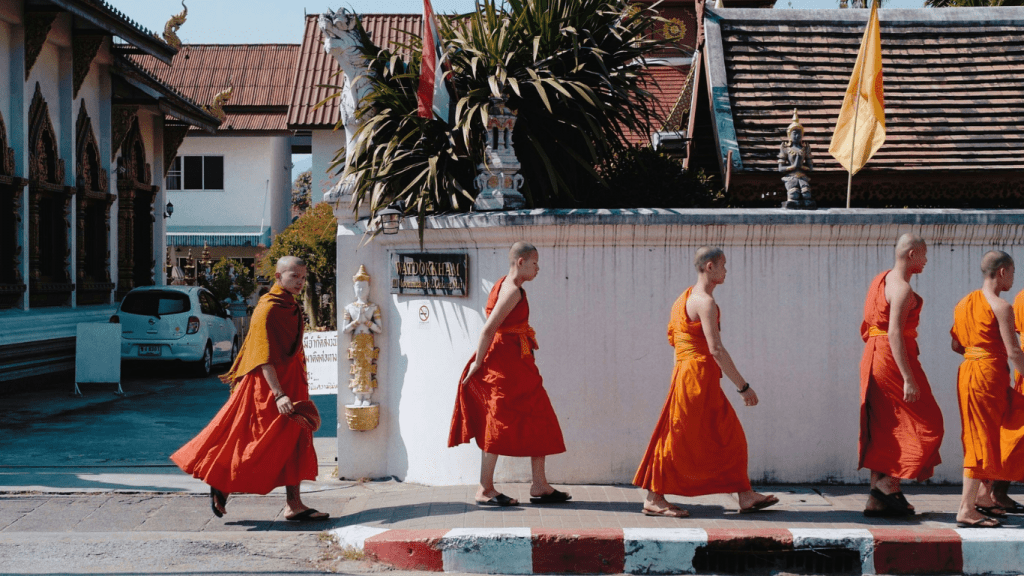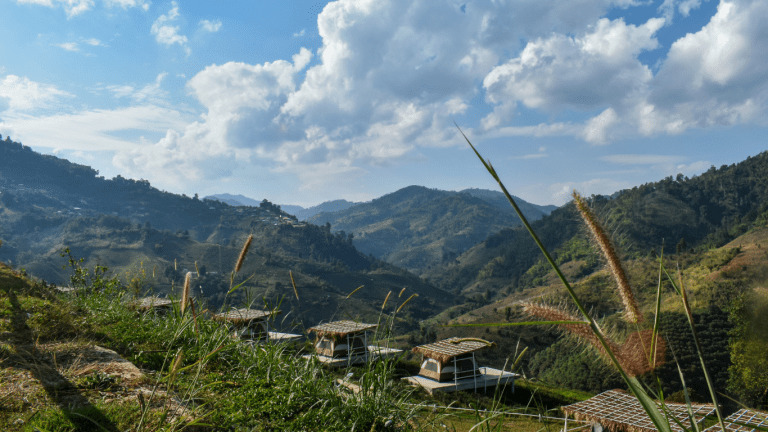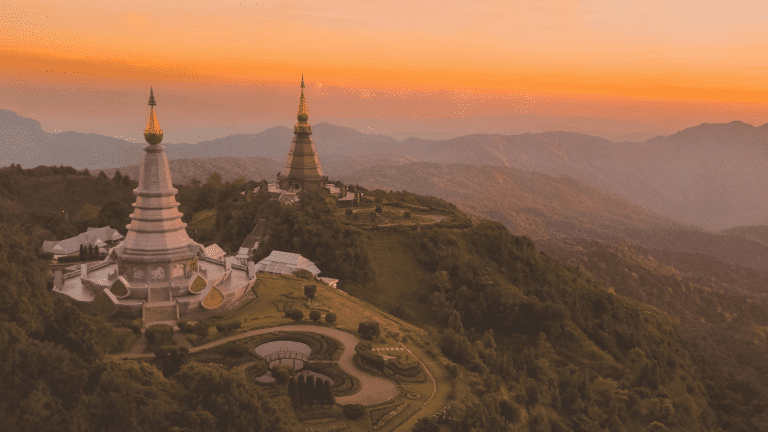Nestled in the mountainous north of Thailand, Chiang Mai is a city that captured my heart from the very beginning. I first moved here in 2018 and ended up staying for a year, drawn in by the peaceful pace of life, the golden temples hidden in leafy alleys, and the hum of night markets that turn ordinary evenings into something special. Founded in 1296 as the capital of the ancient Lanna Kingdom, Chiang Mai still carries echoes of its royal past – from moated old city walls to centuries-old temples where saffron-robed monks quietly walk past.
When Tommas and I returned in 2024, we were curious to see how much had changed – and how much had stayed the same. Spoiler: it’s just as magical, if not more. Whether you’re a digital nomad, a nature lover, or a slow traveller in search of calm, Chiang Mai has something to offer you.
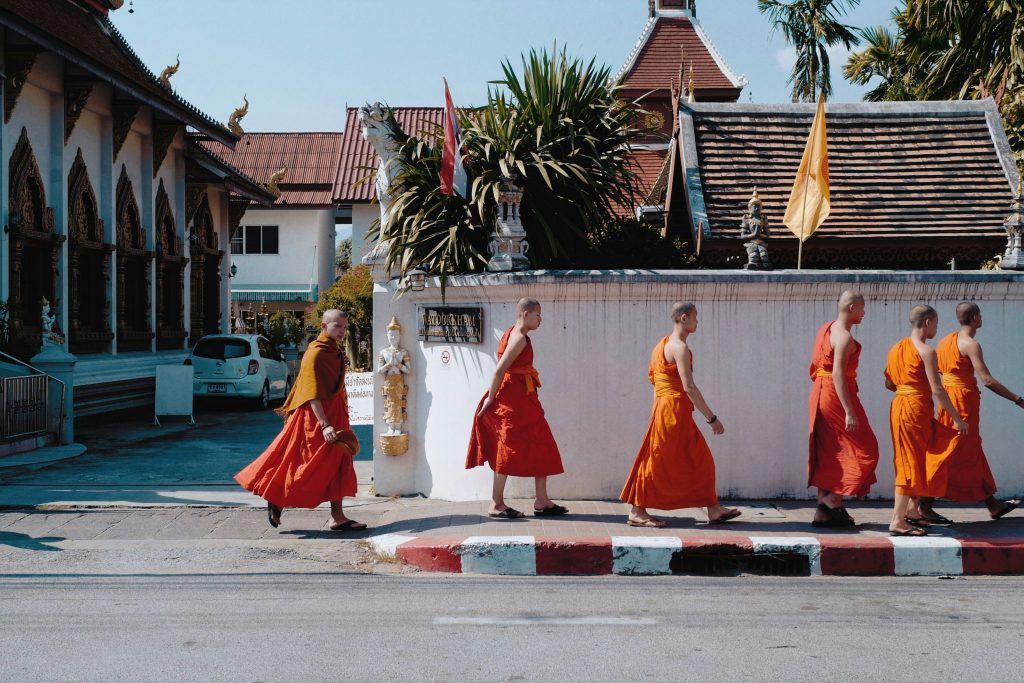
How to Get to Chiang Mai
Chiang Mai is the biggest city in the north, making it easy to reach – whether it’s from abroad, Bangkok or elsewhere in the country. If you’re planning on travelling to Chiang Mai from Bangkok, make sure to check out our guide covering all your transport options!
Flying to Chiang Mai
Flying is the quickest and most convenient way to reach Chiang Mai from Bangkok or abroad. Chiang Mai International Airport (CNX) is well-connected, with daily domestic flights from Bangkok (around 1h 15min) and international connections to destinations like Kuala Lumpur, Singapore, and Seoul. Budget airlines like AirAsia, Nok Air, and Thai VietJet offer frequent and affordable flights.
Taking the Train from Bangkok
If you’re after a more scenic (and romantic) journey, we recommend taking the sleeper train from Bangkok’s Krung Thep Aphiwat Central Terminal (formerly Hua Lamphong). Trains run both during the day and overnight, with 1st and 2nd class sleeper cabins available. The ride takes 11–13 hours, and you’ll arrive refreshed and ready to explore.
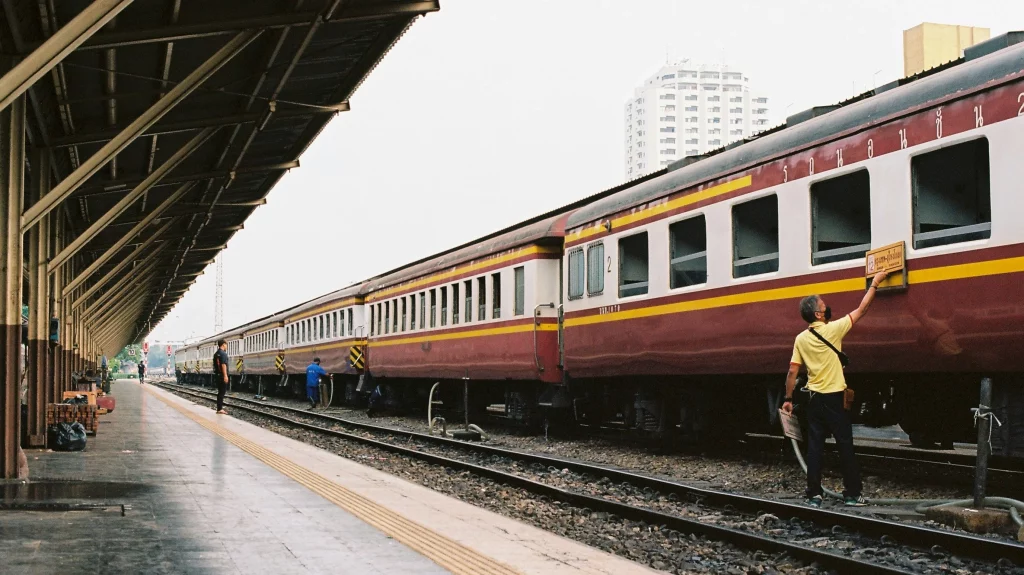
Travel tip: Book your train ticket in advance during high season. You can do this via 12Go.Asia or at the station itself.
Taking the Coach to Chiang Mai
Regular buses are departing from Bangkok’s Mo Chit Bus Terminal. The journey takes around 10 hours. VIP buses are your best bet if you’re looking for comfort. Still affordable, they come with reclining seats and snack boxes.
We took a bus from Chiang Mai to Bangkok and booked our tickets via BusOnlineTicket. We only paid 658 THB per person, and our tickets included a snack, water, and a main meal. The bus had reclining seats, air conditioning, and onboard toilets. Overall, it was a very comfortable and smooth experience for a very small price.
Read more about our experience taking the bus from Chiang Mai to Bangkok here.
How to Get Around Chiang Mai
Getting around Chiang Mai is easy and relatively stress-free, especially if you’re staying within the Old City or Nimmanhaemin area. It is easy to reach most sights on foot. But Grab, buses and Songthaews (red cars) make it easy and affordable to get around the city.
Rent a Scooter
Renting a scooter is by far the most flexible way to explore Chiang Mai and its surrounding area. Especially if you’re planning on visiting Chiang Dao, Mon Jam or Huay Tung Tao, renting a scooter will make your journey easier and more flexible. Daily rentals start from 200–300 THB. Note that you’ll need a valid international driver’s licence with a motorcycle endorsement. It isn’t uncommon for Thai police to set up checkpoints on the main road around the old town to stop foreigners and fine them for driving without an international driver’s licence. Fines (or bribes) can range anywhere from 100 -1000 THB.
Use Grab
Grab (Southeast Asia’s Uber) is widely available and reliable. It’s one of the easiest ways to get around, especially if you’re not comfortable riding a scooter. Prices are fair, and it’s ideal if you’re heading a bit further out, like to Huay Tung Tao Lake or Wat Umong. It’s also a convenient option if you’re out late at night when other transport options are limited. We used Grab a lot while we were in Thailand, especially whenever we were travelling with a lot of luggage.
Take a Songthaew
The iconic red trucks (songthaews) run in and around the Old City and are my favourite way to get around town. Just wave one down and tell the driver your destination. A ride typically costs 30–50 THB per person, but can also cost you 100 THB or more. The rates are not fixed, and foreigners usually pay more than Thai people.
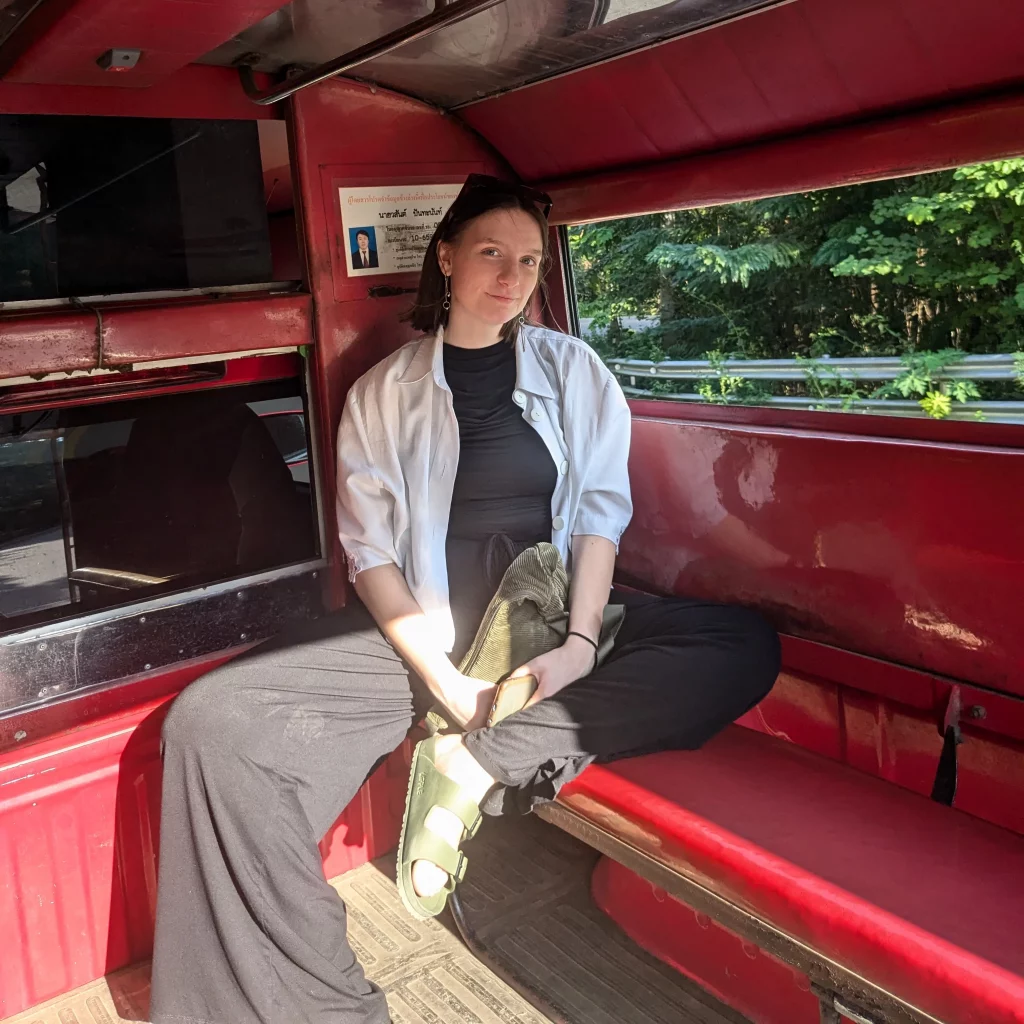
Hop on a Bus
If you’re looking for an affordable and surprisingly comfortable way to get around the city, the RTC Chiang Mai Smart Bus is a great option – and it’s often overlooked by tourists. Launched in 2018, this air-conditioned city bus service covers most major areas of Chiang Mai, including temples, markets, shopping malls, and even the airport. You can find more information on routes and rates on the RTC’s official Facebook page.
Top Things to Do in Chiang Mai
Chiang Mai is a treasure trove of cultural landmarks, lush green escapes, and local experiences. From must-see temples to unique creative spaces and family-friendly outings, here’s a deeper dive into what you shouldn’t miss:
Must-See Temples in Chiang Mai
Chiang Mai, as the centre of the former Lanna Kingdom, has no shortage of incredible Buddhist temples – or wats, as they call them in Thai. Out of the over 300 temples this city and province have to offer, I have probably visited over 50 – and each and every one of them has something special. While walking around Chiang Mai, you’ll find a temple around every corner.
Wat Chiang Man
Wat Chiang Man is the oldest temple in Chiang Mai. Located in the northeast corner of the Old Town, this peaceful temple was established in 1296 by King Mangrai. Though often overshadowed by larger sites like Wat Chedi Luang or Wat Phra Singh, we loved Wat Chiang Man for its unique architecture. Its most striking feature is the Chedi Chang Lom, a golden stupa surrounded by 16 stone elephants, seemingly supporting the structure on their backs.
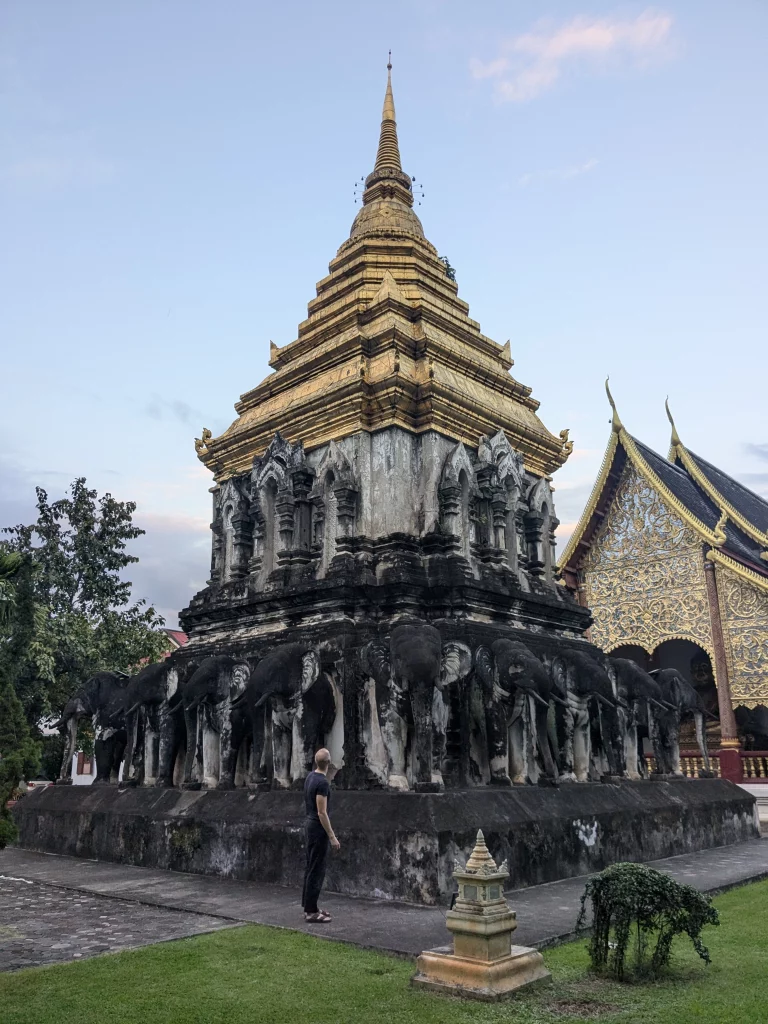
Wat Phra That Doi Suthep
No visit to Chiang Mai is complete without a trip to Wat Phra That Doi Suthep, the city’s most iconic temple, perched on a forested mountain about 15 km from the city centre. The golden chedi at the centre is believed to house a relic of the Buddha himself, and on clear days, the panoramic views of Chiang Mai from the temple terrace are breathtaking.
You can reach Doi Suthep by Grab, songthaew, or scooter if you’re confident with the winding road. If you’re planning on taking a songthaew, make your way to Chiang Mai Zoo. There, you’ll find many red cars waiting to drive visitors up to Doi Suthep. Simply sit down and wait for enough people to arrive to fill a red car. Prices for this journey are set, so no need to haggle.
From the car park at Doi Suthep, you can either climb the 306 steps or take a cable car for 20 THB. Entrance for foreigners is 50 THB. The opening hours of Wat Phra That Doi Suthep are 6:00 AM – 8:00 PM. We would suggest going in the early evening, so you can enjoy a beautiful sunset overlooking Chiang Mai.
Wat Phra Singh
Famous for its intricate Lanna architecture and revered Buddha image, this temple sits at the end of Ratchadamnoen Road. The temple was originally built in the 14th century to house the ashes of King Phayu’s father, and it has since become a symbol of the city’s spiritual heritage. Wat Phra Singh is particularly vibrant during Songkran (Thai New Year in April), when it becomes the centre of festivities, with processions, water-blessing rituals, and a lively yet reverent atmosphere.
Wat Phra Singh is easy to reach on foot or by songthaew from anywhere in the Old City. If you’re staying further out, taking a Grab is your best bet. It’s a particularly beautiful temple to visit in the late afternoon, when the golden chedis reflect the soft light and monks begin their evening chants. The temple opens at 6:00 AM and closes at 5:00 PM. The entrance fee is 20 THB for foreigners.
Wat Chedi Luang
Just a short walk from Wat Phra Singh, Wat Chedi Luang is a partially ruined temple that once housed the Emerald Buddha, now in Bangkok. Built in the 15th century, its massive brick chedi was once the tallest structure in the Lanna Kingdom. Although it was damaged by an earthquake in the 16th century, it still stands as one of Chiang Mai’s most iconic and photogenic landmarks.
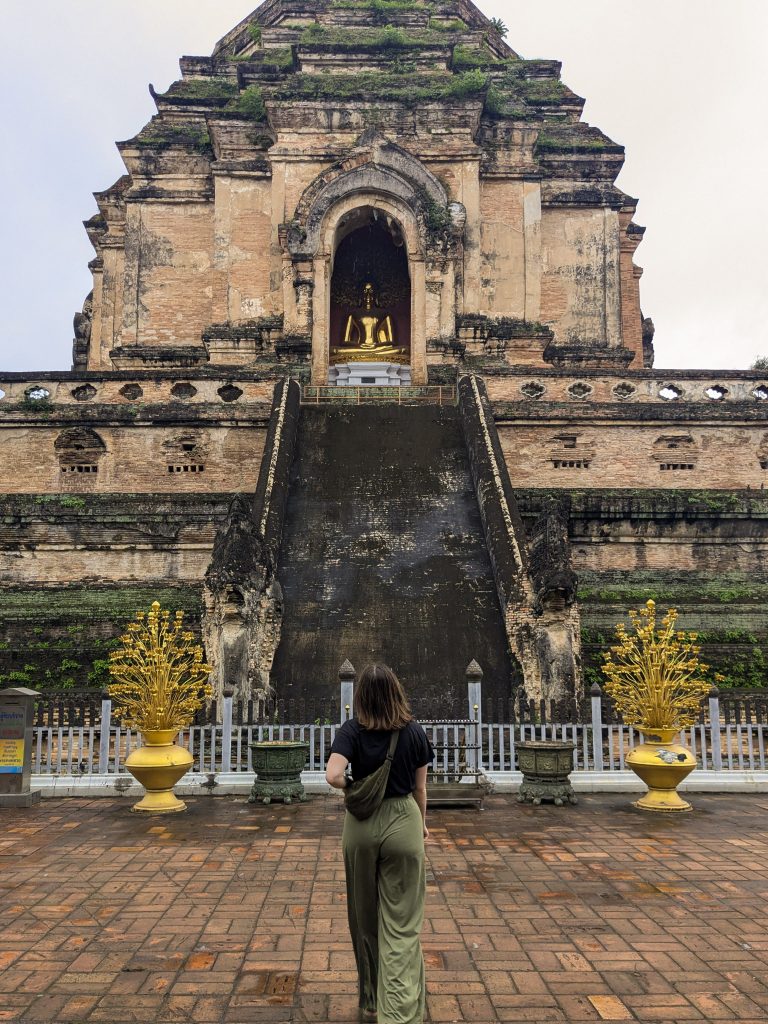
You can easily walk here from most parts of the Old Town. If you’re staying in Nimmanhaemin or further out, take a Grab or hop on a red songthaew. Wat Chedi Luang’s opening hours are 6:00 AM – 6:00 PM, and the entrance fee is 40 THB for foreigners.
Wat Umong
Last but not least, is my favourite temple and one of Chiang Mai’s most unique temples: Wat Umong. The temple’s most striking feature is a network of ancient meditation tunnels built beneath a large brick chedi. The tunnels are dimly lit, cool, and lined with niches containing Buddha statues. Set in a forested area, the temple grounds feel worlds away from city life.
You can get to Wat Umong easily by Grab or Songthaew. However, getting back to the city might be a bit trickier. We had to wait about 30 minutes for our Grab as there were so many others who also wanted to make their way back to the city. So just keep that in mind.
Creative & Local Spots
Chiang Mai has long been known as Thailand’s creative capital, with a thriving arts scene that blends tradition and innovation. From handmade ceramics and silk weaving to modern galleries, street art, and co-working cafés, the city is bursting with creativity. Walking through Chiang Mai’s streets, this becomes apparent around every corner. Here are two of our favourite creative spots:
Baan Kang Wat
Located near Wat Umong, you can find this beautiful little artisan village called Baan Kang Wat. This spot has independent art studios, boutique shops, weekend workshops, and a laid-back café culture. It’s one of our favourite spots for slow afternoons filled with window shopping and good coffee.
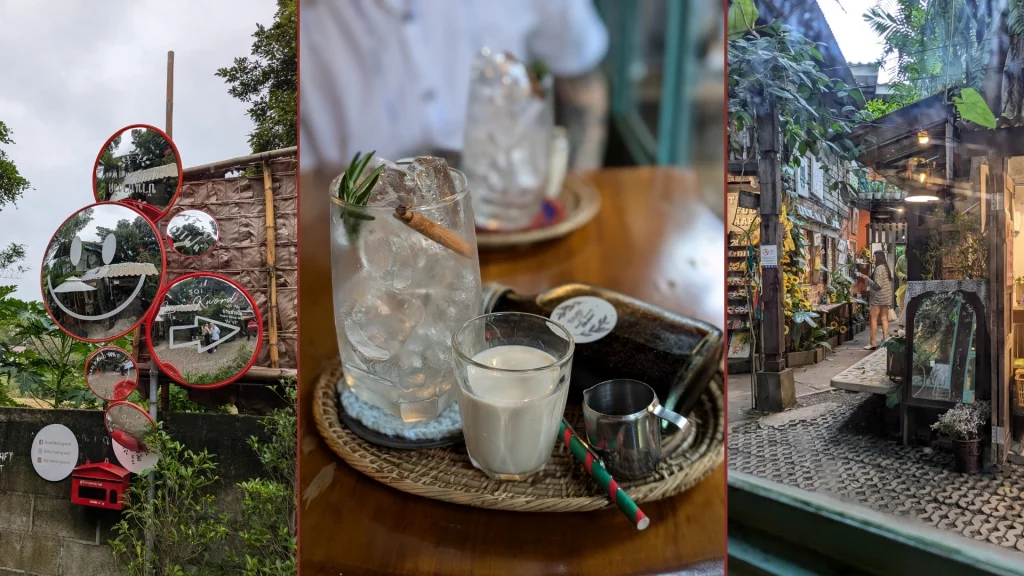
Jing Jai Market
Held on weekends just north of the Old City, Jing Jai is an organic farmer’s market with a vintage twist. A few years ago, this was still a small market with only a few stalls. Now, it’s a big market with so many stalls, it’s impossible to look at everything. Sip artisan coffee, browse handmade crafts, and listen to live acoustic music under shady trees.
Chiang Mai Zoo & Aquarium
Often overlooked, Chiang Mai Zoo is located near the base of Doi Suthep and makes for a great family outing or relaxed half-day trip. The zoo is large and home to over 400 species, including elephants, giraffes, and pandas (when on loan from China). Its adjoining aquarium features Southeast Asia’s longest underwater tunnel and is surprisingly impressive.
Entry is 150 THB for adults and 70 THB for children (separate tickets for the aquarium). It’s best to go early in the day when it’s cooler, as the grounds are extensive and semi-hilly.
Escape into Nature
Chiang Mai is surrounded by lush landscapes, misty mountains, and peaceful getaways that feel worlds away from the city, yet are all within a day’s reach. If you love fresh air, hiking trails, and scenic drives, here are some of our favourite outdoor escapes:
Huay Tung Tao Lake
Just a 20-minute drive from the city centre, Huay Tung Tao Lake offers an authentic local experience. This man-made reservoir sits at the foot of Doi Suthep and offers many bamboo huts where you can relax, order food, and dip your toes in the water. It’s ideal for a slow afternoon of swimming, reading, or enjoying grilled fish and sticky rice served lakeside.
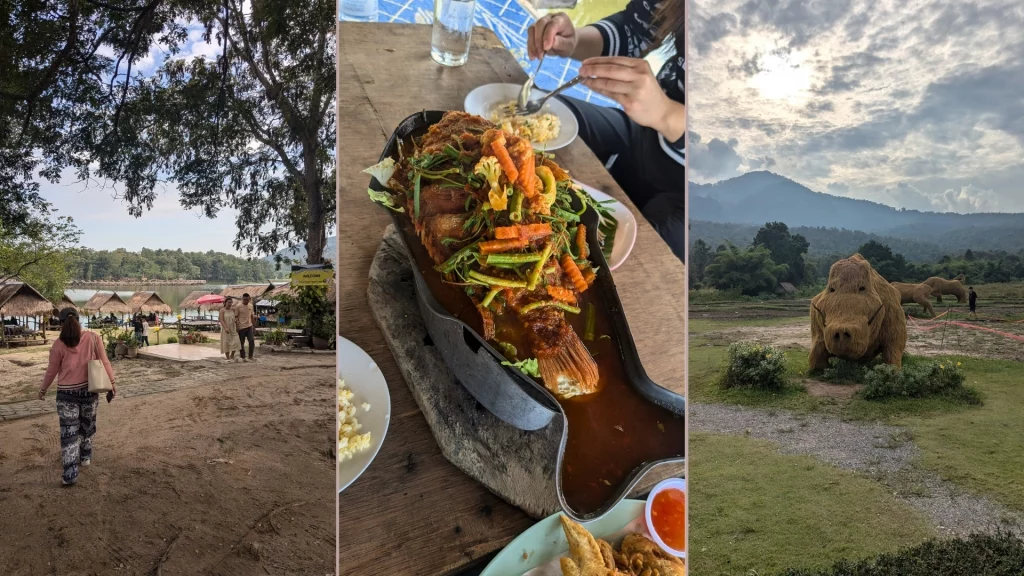
What makes Huay Tung Tao especially charming is the collection of giant straw animal sculptures scattered throughout the park – think elephants, dragons, and dinosaurs crafted from rice straw. There are also paddle boats and bike rental options for the more active traveller. Entry is just 50 THB per person, and parking is available on-site. The best way to get to Huay Tung Tao is by car or scooter. Alternatively, you can take a Grab.
Mon Cham (or Mon Jam)
For a breath of fresh, cool mountain air, Mon Cham (sometimes spelt Mon Jam) is one of the best day trips from Chiang Mai. Located in the Mae Rim district, about 45 minutes by motorbike or car, Mon Cham is a hilltop haven with terraced flower gardens, panoramic valley views, and tiny cafés perched on wooden platforms that make you feel like you’re floating above the world.
Originally developed as part of a royal agricultural project, the area is now dotted with glamping tents (glamping in Mon Cham has been on my bucket list for years now!), organic farms, and small restaurants that serve locally grown food. Many locals travel to Mon Cham to take photos with the blossoming flowers. To get there, you’ll need to have your own car or scooter.
Chiang Dao
Roughly 1.5 hours north of Chiang Mai, Chiang Dao is a picturesque mountain town famous for its dramatic limestone cliffs, cave temples, and natural hot springs. Highlights include the cave temple Wat Tham Chiang Dao, the jungle hike to Wat Tham Pha Plong, and a refreshing dip at the Srisangwan Waterfall. If you have time for an overnight stay, we highly recommend it – we wrote a full guide to Chiang Dao here.
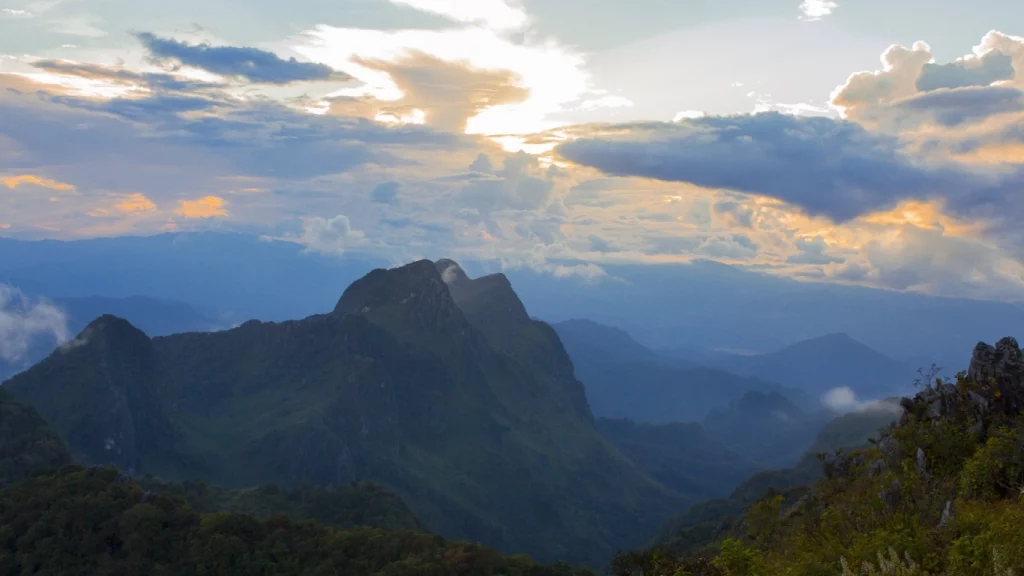
Doi Inthanon National Park
Home to Thailand’s highest peak, Doi Inthanon rises 2,565 metres above sea level. The mountain offers cooler temperatures, cloud forests, and epic viewpoints. Popular stops include the King and Queen Pagodas, Wachirathan Waterfall, and the Kew Mae Pan Nature Trail. It’s a great day trip from Chiang Mai, but even better if you stay overnight in a nearby village.
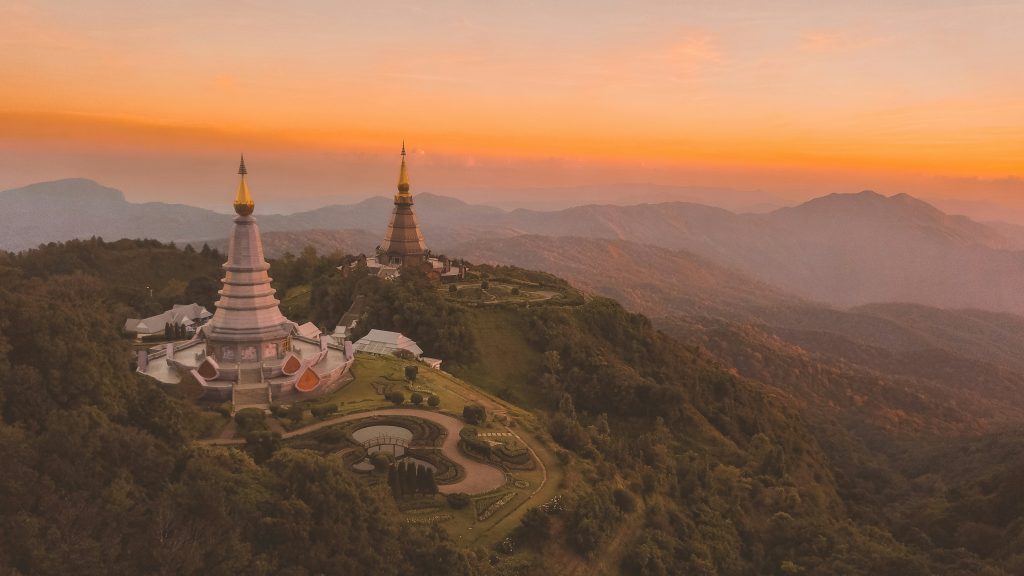
Entrance to Doi Inthanon National Park is 300 THB for foreigners. Bring layers – it gets chilly at the summit even during the hot season!
Didn’t find anything you like? For more unique things to do in Chiang Mai, click here!
Where to Eat in Chiang Mai
Chiang Mai has many amazing restaurants and street food markets – ideal for foodies. While you’re in the north, make sure to try traditional northern food like Khao Soi, Sai Oua or my personal favourite Gaeng Kanoon (jackfruit curry). From markets and food stalls to fancy restaurants, these were some of our favourite food spots in Chiang Mai:
- Khao Soi Mae Sai – This Khao Soi restaurant has had a reputation for serving Chiang Mai’s best Khao Soi for years. Since getting on the Michelin guide, it’s gotten even more popular, with long queues of 30+ minutes being the norm. It’s authentic, spicy and delicious. But expect to bring enough time with you.
- Khao So-i – This Japanese-inspired restaurant is a trendy reinterpretation of the classic Khao Soi. This fusion restaurant is a bit more expensive than your usual Khao Soi restaurant, but we liked it for its different approach to this traditional dish.
- Huen Muan Jai – This place is rustic and delicious. It serves traditional northern Thai dishes, so make sure to try the Hung Lay curry, Sai Oua (northern sausage) or Gaeng Kanoon. Just like Khao Soi Mae Sai, it’s in the Michelin guide and therefore quite popular. We got to the restaurant only 10 minutes after it opened and got one of the last available tables.
- Chang Phuak Gate Night Market – This is one of my favourite street food markets in Chiang Mai. It’s easy to reach as it’s right outside Chang Phuak Gate. The market offers everything from smoothies and mango with sticky rice to Som Tam and Khao Soi. Two particularly popular stalls at this night market are Suki Changphuak and Pork Leg Rice.
- THE HOUSE by Ginger – If you’re looking for a more expensive establishment, look no further than THE HOUSE by Ginger. This fusion restaurant is ideal for a romantic evening out or a farewell dinner.
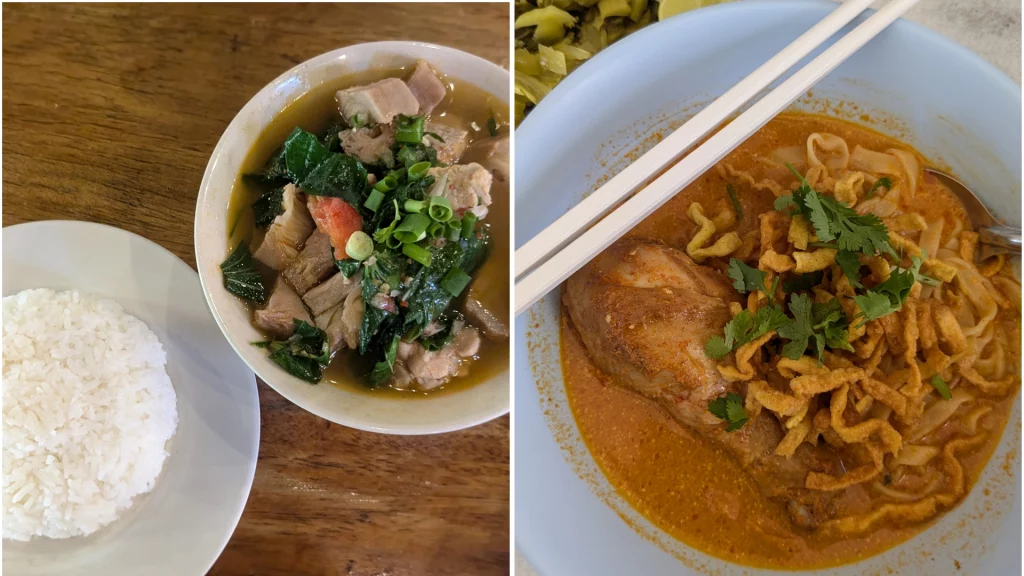
Where to Stay in Chiang Mai
Chiang Mai has no shortage of charming, affordable, and beautifully designed places to stay. Whether you’re on a backpacker budget or looking for a boutique hideaway, here are our top picks. The city is small and walkable, but each neighbourhood has its own unique vibe. Some areas are perfect for first-timers, backpackers and budget travellers, while others are perfect for digital nomads or families.
If it’s your first time in Chiang Mai, staying in the Old Town is a no-brainer. This area is the heart of the city, surrounded by ancient walls and filled with temples. You can stroll through charming streets, visit famous temples like Wat Phra Singh and Wat Chedi Luang, and soak in the colourful Lanna heritage.
Kavil Guesthouse
In November 2025, we spent one week staying at Kavil Guesthouse. The location of this cosy guesthouse is ideal for anyone who wants to experience the Old Town and explore Chiang Mai on foot. Kavil Guesthouse lies right between Rachadamnoen Road – where the famous walking street takes place every Sunday – and Ratvithi Road – a popular area with many bars and clubs. Even though the location of this accommodation is pretty much perfect, you only have to spend 25€ per night to get a room overlooking Wat Chedi Luang.
Sakulchai Place
After spending one week in the Old Town, we decided to extend our stay in Chiang Mai and spent one week at Sakulchai Place. The hotel is located on Huay Kaew Road and is between the Old Town and the trendy Nimmanhaemin neighbourhood, putting it in an ideal location for anyone travelling without their own mode of transport. Sakulchai Place has an outdoor pool, a small gym, a restaurant and offers laundry services and car rentals. We really enjoyed our stay at Sakulchai Place and can only recommend it to anyone planning on staying in that area of Chiang Mai!
Unsure where in Chiang Mai you want to stay? Check out our guide to Chiang Mai’s best neighbourhoods here!
When to Visit Chiang Mai
From vibrant festivals under crisp blue skies to lush green hills after monsoon rains, each time of year has its own character. That said, there are some clear pros and cons – especially when it comes to air quality, tourism levels, and weather conditions. Here’s a detailed breakdown to help you plan your visit.
Best Time to Visit
This is widely considered the high season in Chiang Mai – and for good reason. From November to February, the weather is at its most comfortable, with daytime temperatures ranging between 20°C and 28°C and cooler nights perfect for sleeping without air conditioning. Skies are clear, humidity is low, and it’s the ideal time for temple-hopping, trekking, and exploring the Old City on foot.
This period also coincides with one of Thailand’s most popular festivals, Loy Krathong. It’s an exciting time to visit Chiang Mai – but unsurprisingly also the most popular time to visit, so book your accommodation in advance and expect larger crowds at major sites.
Rainy Season
From June to October, Chiang Mai experiences its monsoon season. Rain usually comes in short, dramatic bursts – often in the late afternoon or evening. Because this is considered the low season, you’ll benefit from fewer tourists, lower prices, and quieter temples.
The countryside comes alive during this time, making it ideal for waterfalls, rice field walks, and green mountain views. Just remember to bring a lightweight rain jacket, waterproof shoes, and a bit of flexibility. Personally, I find the rainy season beautiful and I enjoy how much emptier the city is during this time (it can get quite crowded during the high season!).
Burning Season (Avoid!)
Between March and May, Chiang Mai enters what’s known locally as burning season – a period when farmers across Northern Thailand burn crop stubble to prepare for the next planting cycle. This leads to hazardous air pollution, with PM2.5 levels often spiking far above safe limits. The sky can turn grey for days, and the once-beautiful mountain views disappear behind a layer of smoke.
Read more about the burning season here.
Final Thoughts
Chiang Mai remains one of our favourite places in Southeast Asia. It has the energy of a city but the soul of a village. Whether you’re here for a few days or a few months, it’s a place that invites you to slow down, breathe deeply, and really take it all in.
If you’re planning your Northern Thailand itinerary, make sure Chiang Mai is at the top of your list – and prepare to fall in love, just like we did.
Have you been to Chiang Mai? Got a favourite café or secret spot we missed? Let us know in the comments below!
